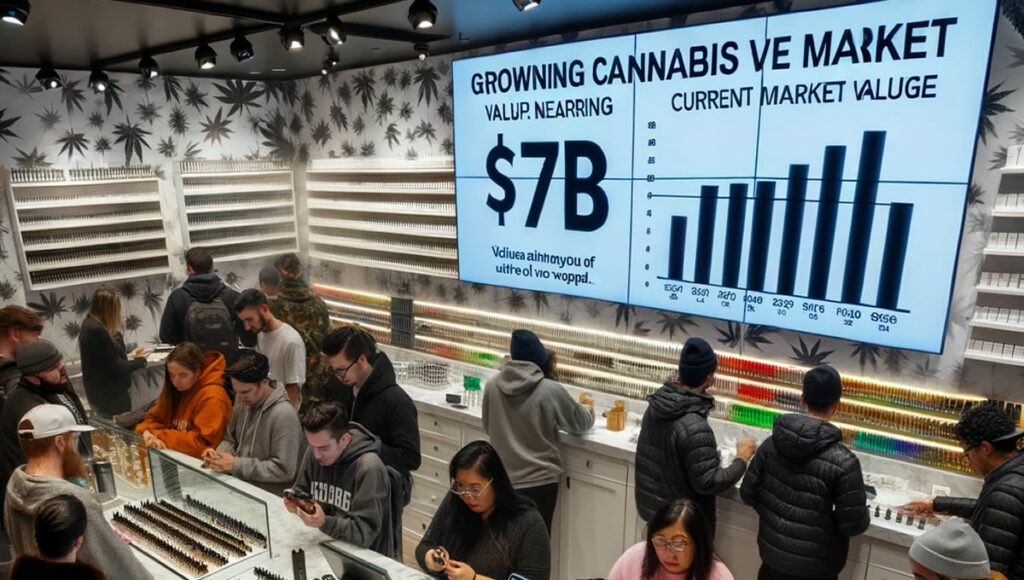The rapid expansion of the cannabis vaping sector in the US has led to sales on par with the nicotine vape market. However, the two industries operate under vastly different regulatory environments. Cannabis vaping remains largely free from federal restrictions while nicotine vaping faces escalating oversight.
Cannabis Vaping Quickly Reaching $7 Billion
According to an October 2022 report by Zuanic & Associates, the US cannabis vape market is expected to hit approximately $6.8 billion in sales this year. With consistent growth annually, some projections estimate it could surpass $7 billion soon.
Vape products currently comprise about 25% of total US cannabis sales, making it the second largest product category behind raw marijuana flower. The market share captured by vaping is far higher compared to its share of the tobacco industry.
These sales numbers likely underestimate the true market size given the substantial illicit cannabis market, which is inherently difficult to accurately track. If illicit sales were included, the cannabis vape market would possibly exceed $7 billion already.
The rapid ascent of cannabis vaping has occurred in the absence of federal legalization. While federal prohibition persists, states have taken individual actions to legalize medical and recreational cannabis use, enabling the legal vape market to flourish.
However, the lack of overarching federal regulation also means safety risks like contaminated products and unverified ingredients remain concerns within the largely unrestricted market.

Nicotine Vaping Faces Regulatory Hurdles
In contrast to the burgeoning cannabis vape sector, the nicotine vape market contends with escalating FDA oversight and restrictions. According to Euromonitor data, the nicotine vaping market hit around $6 billion in sales in 2021.
Despite potential public health benefits from transitioning smokers to less harmful vaping, the FDA continues imposing new limits on the nicotine vape industry. These include constraints on flavors, youth access, nicotine concentrations, and disposable vape devices.
Most recently, the FDA denied marketing authorization for flavored Vuse Alto e-cigarettes from major manufacturer RJ Reynolds. This follows similar FDA actions against leading nicotine vape company Juul, signaling intensifying regulatory scrutiny.
Although nicotine vapes have existed in the US for over 15 years, the market remains a relatively modest portion of the $144 billion tobacco industry. Vaping accounts for less than 5% of total tobacco sales, whereas cannabis vaping makes up about 25% of the cannabis market.
The cannabis vape sector has flourished largely outside federal oversight. In contrast, escalating FDA regulation inhibits growth and innovation in the nicotine vaping space.

Vape Hardware Manufacturers Target Cannabis Market
With few restrictions on the cannabis vape industry thus far, manufacturers of vaping device hardware view it as a major opportunity for expansion.
Zuanic & Associates estimates the US cannabis vape hardware market alone represents a $700 million market currently. This excludes sales of actual cannabis vape formulas and oils.
Prominent vape tech manufacturers focused on the cannabis space include China-based CCELL, Advanced Vapor Devices, and Nasdaq-listed supplier Ispire. Their prospects diverge significantly from nicotine vape hardware makers navigating FDA rules.
These companies and others are rapidly innovating to capture growing consumer demand as the cannabis vape market blossoms in the absence of regulation. However, some analysts suggest disposable vapes could potentially prompt new oversight given their appeal to youth and environmental concerns.
Future Cannabis Legalization May Bring More Control
A key factor allowing the cannabis vape market to expand exponentially is the lack of federal prohibition and oversight. But most observers believe national legalization is inevitable, whether in the near future or years down the road.
With legalization would likely come greater FDA regulatory powers over cannabis vaping to address risks posed by unsafe products. Tighter control over formulations, testing, manufacturing, labeling, and more could be implemented for consumer protection.
Such regulation has both benefits and drawbacks for the market’s development. But for the time being, cannabis vape continues growing mostly unrestrained while nicotine vape faces intensifying restrictions.
- Pennsylvania Mandates Vape Product Registry for Shops - December 24, 2025
- Kyrgyzstan Imposes Six-Month Ban on E-Cigarette Imports - December 24, 2025
- US Reclassifies Marijuana to Schedule III: Key Impacts - December 22, 2025


